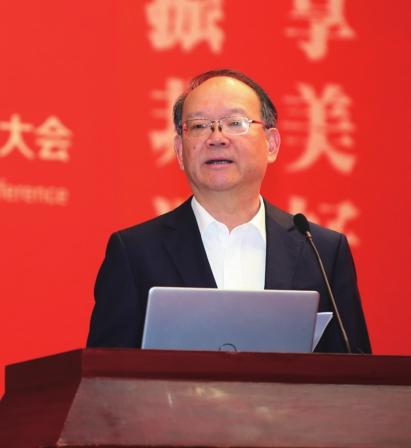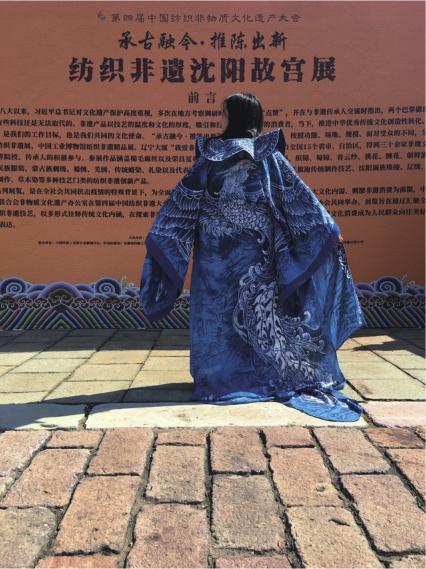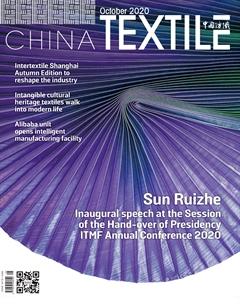Boost enjoyable consumption,create a better life

Good morning ladies and gentlemen,
The China Textile Intangible Cultural Heritage Conference has been held in Zhejiang, Beijing and Yunnan for three consecutive years. Last year, it was also honored to be selected as one of the “Top Ten Events of Chinas Intangible Cultural Heritage”. Its influence has been highly concerned by the society. This year, the 4th China Textile Intangible Cultural Heritage Conference was held in Shenyang in northeast China for the first time. It was advised by the Ministry of Culture and Tourism, the Ministry of Industry and Information Technology, and strongly supported by the Publicity Department of the CPC Shenyang Municipal Committee, Liaoning Textile and Garment Association, Shengjing Manchu Embroidery Culture Group Company and One World One Sight (Liaoning) Intangible Cultural Heritage Communication Co., Ltd. Here, on behalf of the China National Textile and Apparel Council, I would like to express my heartfelt thanks and sincere respect to all participants from all over the country.
This conference was held at the time when the country won the victory in the fight against the COVID-19 pandemic, and the macro economy showed recovery growth, and the national 13th Five-Year Plan, the construction of a well-off society and the fight against poverty have entered the final sprint stage. Chinas economic and social development will be based on sustained strategic deployment, gradually established a new dual circulation strategy with the domestic cycle as the mainstay and the domestic and international cycles reinforcing each other, which provides a strategic direction for Chinas development during the 14th Five-Year Plan. From the perspective of the textile industry, since the beginning of 2020, the economic operation of the industry has been hit hard by the COVID-19 pandemic, and various indicators have shown a large decline. However, after the joint efforts of the entire industry and the policy support of government at all levels, the operation of industry started to bottom out in the second quarter. The market is getting better, domestic physical and virtual sales are picking up, and household consumption is showing a recovery trend, and the entire industry gradually return the track of healthy development.
As a part of the development of textile industry, the textile intangible cultural heritage is difficult to find a good sales in the industry statistics for its production and consumption, and it has also been severely affected in this year. However, textile intangible cultural heritage insiders are always taking their own responsibility, fighting with the pandemic and poverty actively, resuming the work and production with their creativity and enthusiasm, and expressing their wise and intelligent ideas in the live broadcast on the network platform, which in line with the mission of inheritance and development of China. As the domestic economic and social order has basically returned to normal, the entire chain of inheritance and development of textile intangible cultural heritage has also begun to operate normally. Today, we gather in Shenyang to hold the 4th National Textile Intangible Cultural Heritage Conference in order to show the entire industry and society: as the organization, coordination and service organization of the textile intangible cultural heritage, we will continue to promote the spiritual concept of Chinese excellent traditional culture and traditional craftsmanship, by combining protection, inheritance and innovation and development, allowing textile intangible cultural heritage to continue to show strong vitality and consumption space in contemporary life, increasing cultural soft power to the transformation and upgrading of the textile industry, and creating a brilliant world for peoples lives.
Last year, at the 3rd Textile Intangible Cultural Heritage Conference held in Kunming, I put forward the theme of “creating a new era of inheritance and development of textile intangible cultural heritage”. This year, after experiencing the severe social and economic fluctuations as mentioned above, it has made us more rationally aware that the new era is full of changes, but paying attention to and solving peoples livelihood, inheriting and developing excellent traditional culture, increasing consumption should always be the focus of textile intangible cultural heritage work. For this reason, the main task of this conference is to study and explore ways to “boost enjoyable consumption and create a better life”. Below, I will focus on three issues for your reference.
1. Why should we emphasize boosting the consumption of textile intangible cultural heritage?
Textile intangible cultural heritage mainly includes spinning, dyeing, weaving, embroidery, printing and national costumes, which basically belong to the category of traditional crafts. National costumes are the integration of spinning, dyeing, weaving, embroidery, printing and related materials, making textile intangible cultural heritage an organically connected technical chain and cultural system. Regardless of history and reality, textile intangible cultural heritage is closely related to the lives of the people, containing folk wisdom, carrying the intangible power of the times and culture, and it is a valuable asset in traditional Chinese culture and traditional crafts. In modern society, peoples lifestyles and aesthetic tastes have undergone tremendous changes. Textile intangible cultural heritage and other traditional crafts are also facing unprecedented survival crises and inheritance tests. It is necessary to consider the strategic issues of how to implement creative transformation and innovative development. This is the responsibility and mission of the textile industry to promote and continue the excellent Chinese traditional culture and traditional craftsmanship. It is also an important strategy for the transformation and upgrading of the industry to express cultural connotation. How to achieve transformation and development? Obviously, we must let the traditional textile culture and traditional crafts bring their own cultural genes and regional characteristics, and integrate them into the mate-rial and cultural life of people through market-oriented methods with innovative designs, functions and material forms. From an economic perspective, life need spiritual and material consumption. Material products containing intangible cultural heritage elements can only be truly integrated into the lives of modern people when they are consumed, and the cultural and economic value of traditional crafts can be truly realized. We should admit that people‘s preference and purchase rate of intangible cultural heritage products are not high.In essence, this is not only the problem of insufficient understanding of the traditional cultural value of textile intangible cultural heritage, but also the low production efficiency, high cost, poor quality of textile traditional craft products and insufficient conformity to current consumption and aesthetic needs. Common sense of economics tells us that the lack of consumer recognition means that there is a lack of space to survive in the market economy, and investment in and contributions to all links of intangible cultural heritage will not be compensated by corresponding economic and cultural values. Related undertakings including poverty alleviation and employment will also have difficulties, and the inheritance and development of intangible cultural heritage will inevitably be unsustainable. Therefore, the emphasis on boosting the consumption of textile intangible cultural heritage is to dig out cultural content, absorb the nutrients of the times, and rejuvenate the market. This is a major event related to whether our intangible cultural heritage business can fit in with the market economy era and achieve sustainable development.
2. What are the basic points to boost consumption of textile intangible cultural heritage?
First of all, it is necessary to develop a diversified consumption field of textile traditional crafts, and design and produce related products in accordance with innovative concepts and consumer needs. According to the basic division of the industry, textile intangible cultural heritage resources can be mainly applied to apparel, home textiles, cultural and tourism, wedding folklore, artistic creation, film and television drama costumes, etc. Those with collection investment value can enter the auction market, and those with national influence can also be used in international exchanges. According to the consumer demand in these different fields, we should follow the ideas of innovation and development and marketization, and under the condition of protecting the essence of traditional culture and traditional craftsmanship, we should update the design concepts and technologies, including the use of materials and the update of content, and the rational use of advanced technical, and improve the creativity, production efficiency and adaptability to market demand of textile intangible cultural heritage products. Excessive emphasis on the protection of“authentic” will only cause the vitality of textile intangible cultural heritage to shrink or even die. The quality of textile intangible cultural heritage products that carry excellent traditional cultural connotations and exquisite skills, but can meet various consumer needs at the moment, and leave people impressive memories.
Secondly, it is necessary to open various channels for effective market promotion, so that consumers can recognize textile intangible cultural heritage products. This is also a common problem facing the development of intangible cultural heritage. During the pandemic, the Ministry of Culture and Tourism took advantage of the China Cultural Heritage Day to use public network platform to hold the “Intangible Cultural Heritage Shopping Festival”. This national market promotion provides us with a channel paradigm that we can learn from and implement. Nowadays, non-governmental network marketing of textile intangible cultural heritage products is full of vitality. This year our intangible cultural heritage promotion ambassador promoted textile intangible cultural heritage mature products to the domestic and overseas markets, and also helped thousands of embroiderers to gain income. There are many successful cases. Many domestic textile intangible cultural heritage resources are concentrated in ethnic minority areas in the western China, where the circulation is restricted by geographic traffic, and there is an urgent need to deliver intangible cultural heritage products with regional ethnic characteristics to more consumers through virtual channels. Therefore, we expect that network marketing will become the norm in the marketing of textile intangible cultural heritage in the postpandemic period. Last year, the Intangible Cultural Heritage Office of China National Textile and Apparel Council, Liaoning Textile and Garment Association, and Dalian Textile and Garment Expo organized the “China (Dalian) Textile Intangible Cultural Heritage Cultural and Creative Brands Special Exhibition”, which is an offline exhibition and sales platform, was praised by the leaders of the Ministry of Commerce and Liaoning Province at that time. This professional exhibition of textile intangible cultural heritage is also an exhibition with very active transactions and has become a highlight of Dalian Textile and Garment Expo, which fully shows that the physical sales channels of textile intangible cultural heritage also have great development potential.
As mentioned above, textile intangible cultural heritage resources can be applied in a wide range of fields, which are closely related to peoples lives. Under the con- ditions of market economy, exploring effective promotion channels and business models suitable for various consumption fields is conducive to the combination of textile intangible cultural heritage and contemporary economic life, and promotes the presentation of economic and cultural value of textile intangible cultural heritage.
3. How to build textile intangible cultural heritage brands to create a better life?
It should be said that this is the key to boost consumption of intangible cultural heritage and creat a better life. These years are the best time to inherit and develop Chinas intangible cultural heritage. The party and government departments attach great importance and support. Various policies and measures of cultural, have been presented, industry and information department continue to support and, industry organizations take the initiative, inheritors, designers, and entrepreneurs, experts and scholars have basically formed a promotion group that enhances inheritance and innovation capabilities. Under the market economy, they have gradually realized that intangible cultural heritage should get out of the state of being “protected”. Only by branding, that is, implanting intangible cultural heritage elements into original brands and being recognized by market and consumer, can the inheritance and development of intangible cultural heritage be carried out more effectively. For example, a top luxury brand in the world has opened a store specializing in typical Chinese intangible cultural heritage products, wich contains many silk and embroidery products. The prices are high but they are quite popular among consumers. Some well-known domestic womens fashion brands in China creatively apply the traditional skills in textile national and world-class intangible cultural heritage projects to clothing design and production. Each piece of clothing has become a unique artwork, which has moved many high-end consumers. It is undeniable that this is the charm of intangible cultural heritage and the power of the brand.
Todays social economy is increasingly dependent on consumption, and the power of a brand always affects the psychology and behavior of consumers. The greater the brands influence, the more consumers are willing to follow. Therefore, building a textile intangible cultural heritage brand is of great significance to boost the charm display and market development of textile intangible cultural heritage in apparel, home textiles, cultural tourism, artistic works, and foreign exchanges. It is necessary to construct a complete textile intangible cultural heritage product brand system through the classification of the inheritance subject and carrier of textile intangible cultural heritage. Specifically include the following:
The first is the intangible cultural heritage project brand. It must be included in the official list. The higher the level of the project, the higher the value of its brand. For example, there are 197 textile projects at the national level and 3 textile projects in the United Nations, and 104 items listed in the list of the first batch of national revitalization of traditional crafts, which should be the top priority in building the brand of textile intangible cultural heritage projects and have corresponding brand value.
The second is the inheritor and designer brand. This is to emphasize the main role of “people” in shaping the intangible cultural heritage brand. Inheritors, especially master-level inheritors, are authorities who are proficient in the traditional skills of intangible cultural heritage. They should be the experts of their fields. They are the brand itself and have their own students. Designers, especially famous designers, should focus on the modern and fashionable application of intangible cultural heritage elements in the textiles and related products, and strive to become the leader in the fashion trend of the textile intangible cultural heritage market.
The third is the product and corporate brand. The result of inheriting and applying traditional craftsmanship must be to use the spirit, wisdom, art and aesthetics to form intangible cultural heritage products, which can be recognized, shared by consumers and have great market influence. If this process goes beyond individual behavior but is completed by the main body of the enterprise and forms an irreplaceable core advantage, the corporate brand will be gradually formed. The formation of intangible cultural heritage product brands and corporate brands requires vigorous promotion of the industrialization and marketization of intangible cultural heritage.
The fourth is national characteristics and regional brands. Textile intangible cultural heritage resources are mostly concentrated in areas inhabited by ethnic minorities, and their characteristics are affected by ethnic culture. These traditional art are the representative cultural symbols of local lifestyle, and also an important means of making a living, employment and creating economic sources. A popular saying in the field of textile intangible cultural heritage is “raising kids while growing flowers, and look after the whole family at the same time”. It is a true portrayal of the production and life of embroidery women in ethnic minority areas. However, how to form national characteristics and regional brand still requires government support, capital introduction, enterprise participation and business operation mode integrated with traditional cultural feelings.
The fifth is national brands with international influence. The inheritance and development of textile intangible cultural heritage should tell the “Chinese story” of intangible culture, link the international fashion trend, and let the nations and countries with the ability to appreciate traditional culture and technology accept Chinas textile intangible cultural heritage, so as to further build China national brands, such as Chines silk, Chinese embroidery and Chinese national clothing, and make important contributions to the cultural trade exchanges between China and other countries in textile and apparel industry.
In general, when the textile intangible cultural heritage truly forms a brand, it will bring market recognition and reputation, and then win the favor of consumers. Then the textile intangible cultural heritage can truly be integrated into modern life, and realize the mission of creative and innovative transformation. Let us all join hands and work hard for “boosting enjoyable consumption and creating a better life”.
Thank you all!
- China Textile的其它文章
- Dear readers
- Hybrid ITMF Annual Conference 2020
- Sun Ruizhe:Inaugural speech at the Session of the Hand-over of Presidency ITMF Annual Conference 2020
- Intertextile Shanghai Autumn Edition to reshape the industry
- Intertextile Shanghai Apparel Fabrics provides the industry energy
- CHIC 2020 comes back strong!

